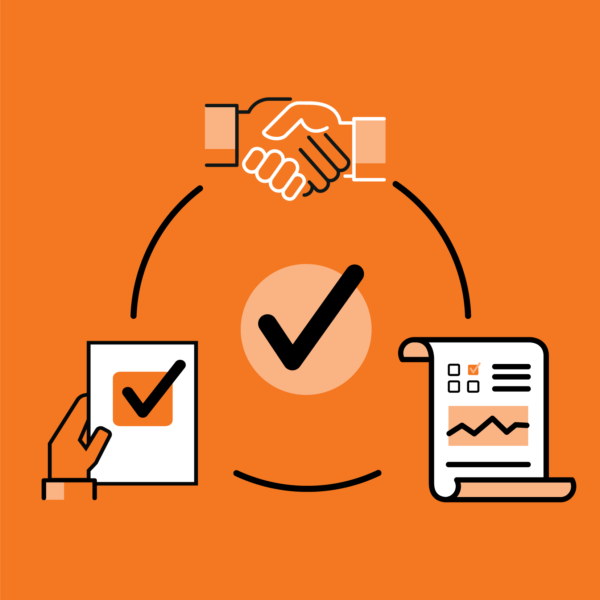Why Decide?

Lean on a group’s collective wisdom to narrow down to a single option or path forward based on known constraints and criteria.
Consider available options, reach consensus, and commit to create a new reality.
- Move groups from an open discussion of alternatives to conversations where they form decision criteria and make a final decision.
- Promote co-creation to allow participants to become more invested in implementation, which is critical to organizational health.
- Close the meeting by reporting out on next steps, action items, and owners of each item.
- Save time at the end of the meeting to explicitly state decisions made by the group and ensure consensus. Otherwise, the participants will not feel committed to follow-on action items.
- Make sure those who will be responsible for implementation are familiar with the decision-making process or contributed to the generation of options in the meeting.
- Avoid combining too many distinct options into one simply for the sake of consensus. This will become confusing and unwieldy. Create a sequence of options to help with prioritization.

Refine Your Outcome

DECIDE outcomes are the shared commitments you are seeking from a group as a result of the meeting.
Based on this meeting, the organization should be more aligned in its actions moving forward.
Document your outcomes in a way that is relevant to the group’s values, culture, and protocol.
- Outcomes are different than outputs. Outputs are physical manifestations (e.g. reports, graphics, participant emotions) of the meeting's success or failure. Outcomes are the decisions, results, or achievements.
- Understand and account for the span of control the participants have within the organization when refining your outcomes. Participants will be more invested in the decision-making process if they can influence the outcomes.
- Your outcomes should incorporate any prior decisions made or results achieved before the meeting.
- Be careful that the intended outcome you are asking the group to attain is possible. Being too aspirational is a common pitfall.
- Set the expectation that some participants may not get their preferred solution with the chosen outcome.
- Avoid diluting the outcome by trying to make it please everyone. The goal is to find the best path forward to meet your outcome.

Determine Your Participants

Identify the fewest, most important people who must be aligned on this decision to make it a reality.
Think ahead to the future you see possible. Who is critical? Who are the key actors in delivering the outcomes you envision?
- Before the meeting: Map out the participant landscape to understand key influencers and invitees, confirm attendees, and get initial buy-in from key influencers on the decision-making process.
- Give each participant a compelling reason to attend. Appeal to their role, expertise, values, and how their input is important to the outcome of the meeting.
- Avoid inviting everyone to the meeting. Consider what conversations you can have before and after the meeting in order to be inclusive and efficient.
- Ensure you keep those not invited to the meeting involved by socializing them with the intent, next steps, and how they can be involved in the decision-making process. Ask them for advice on what positions may be presented in the meeting, context on why these positions matter, and then circle back to share your story how their advice contributed to the success of the meeting.

Plan Your Decision Protocol

A decision protocol is the method and guiding principles by which you will make your decision.
Guiding principles are the values and criteria that keep the decision-making protocol human-centric.
You might come to a consensus, vote, or provide a recommendation to the final decision-maker.
- A working definition of consensus includes: the process was explicit, rational and fair; everyone in the group feels they were heard; and participants can live with and are committed to the outcomes.
- A targeted tactic for groups to come to a decision on specific discussion points when consensus cannot be achieved is voting. If that does not work, a recommendation is another method that can be used to empower groups to make a decision.
- For voting, utilizing a decision-support tool such as sticky dots, raised hands, balloting, or electronic polling during the meeting.
- State an observed common ground/agreement early to build rapport within the group.
- Don't attempt to get the group to agree with everything. A working definition of consensus allows diversity of opinion to exist and enables the group as a whole to move forward.
- When voting, watch out for participants with stronger personalities who may influence the group heavily in one direction. This should be discussed ahead of time to avoid derailment during the process. Consider rounds of voting as a means to manage strong personalities in a group.
- When using a recommendation, avoid informing the group that their input is akin to a final decision. Their vote may not ultimately be implemented. Build credibility by stating the reality up front.

Talk Options Before Taking Positions

Brainstorm a list of all possible options.
Think of as many combinations as possible, without judgement, before taking a position.
- Collect a sample of options in advance of the meeting that the facilitator can introduce to spark the discussion. Invite participants to contribute to the sample options by suggesting their best ideas.
- Take a moment to explore the potential impact of a solution on multiple stakeholders in the organization to test its viability.
- Break conversations into two parts: 1) discuss options and 2) take a position. This distraction allows time to clarify where there are true agreements and disagreements.
- Listen carefully for participants who suggest self-serving options alone, as opposed to options that also benefit the whole. Both may be considered "right" and, given the conditions and circumstances, one might be more favorable to the outcome a group is seeking.
- Be careful to not let the fear of potential implementation challenges get in the way of transformational solutions.
- Be sure to manage the clock to allow appropriate time for decision-making and sufficient discussion for viable options to emerge. Case-making and constructive conflict are key to shared coordinated action following the meeting.

Invite the Voice of the Critic

After talking options, allow the group to take positions.
Invite the Voice of the Critic into the conversation.
Welcome constructive conflict into the room, encourage participants to take a position, and engineer the debate in a way that brings forth diverse thinking.
- Use the Voice of the Critic to tease out, "What is the option aiming to achieving?" This will help uncover its desired intent. If the proposed option is not viable for the desired intent, ask the group, "How else might you achieve the goal?"
- Use constructive criticism. Frame the feedback from the Voice of the Critic in a positive light. The feedback will identify gaps and also fortify the case for implementation of a given option.
- At the close of the exercise, ensure the group has a collective picture of the conversation. Ask, "Can we agree this gives us a sufficient evaluation of the options, including the merits and associated challenges?"
- Avoid focusing the conversation on the originator of the idea; explore the merits of the options instead. The Voice of the Critic is not an opportunity for participants to personally attack one another.
- Watch out for participants who repeat their position throughout the meeting. This can cause groups to get stuck or stall the conversation.
- Remember to engage key influencers to help critique if you observe they are holding back their point of view. A facilitator can call on them or use small group breakouts to spark discussion.

Narrow and Close

Apply your decision protocols to help the group narrow the available options.
After the discussion of options, pivot the focus of the group towards achieving the intended DECIDE outcome.
- When you narrow and close you will feel a shift in the energy as the results of the meeting begin to become concrete.
- Use voting to narrow options down to a manageable list for final consideration. Have participants identify and then rank options. Cycle through 2-3 rounds of voting, having participants state their case for their chosen option after each round. Once completed, the group should arrive at a final decision.
- When ranking a list, compare options in pairs. Begin with the bottom options and ask, "Is B more important than A?" If yes, B moves up the list. Then ask, "Is B more important than C?" The option moves up until the answer is no. Continue until all options have been ranked.
- Beware of political risk for participants taking a public position. Leverage an anonymous digital polling tool that interfaces with participants' smartphones.
- Avoid using option comparison with groups who are highly analytical and require a transparent, rigorous method to identify a top option.

Acknowledge and Celebrate

Always remember to acknowledge and celebrate:
- Articulate what the group is aligned on
- Note moments of conflict and resolution
- Get specific on how this information will and will not be used moving forward
- Celebrate the work participants did in the meeting and what was accomplished
- Emphasize how the outcome of the meeting is "real" and considers known factors and constraints. The meeting owner might reconvene the group if new information requires a course change.
- Confirm with participants that their input has helped identify the path forward and given insight into the organization's priorities. The robust discussion used to achieve a decision will serve as a guidepost during implementation.
- Revisit the guiding principles of the group and the organizational culture. Identify ways the group "fought like allies" in service of the organization.
- Avoid over-promising what results will be achieved because of the meeting. Instead, commit to tactical steps. Consider sending a note to participants' supervisors about the positive impact their participation had on the process.
- Don't forget to state how well the group performed, despite areas of conflict and difference. Positive group experiences build strong memories for an organization and allow participants to feel that the work they performed together matters.

